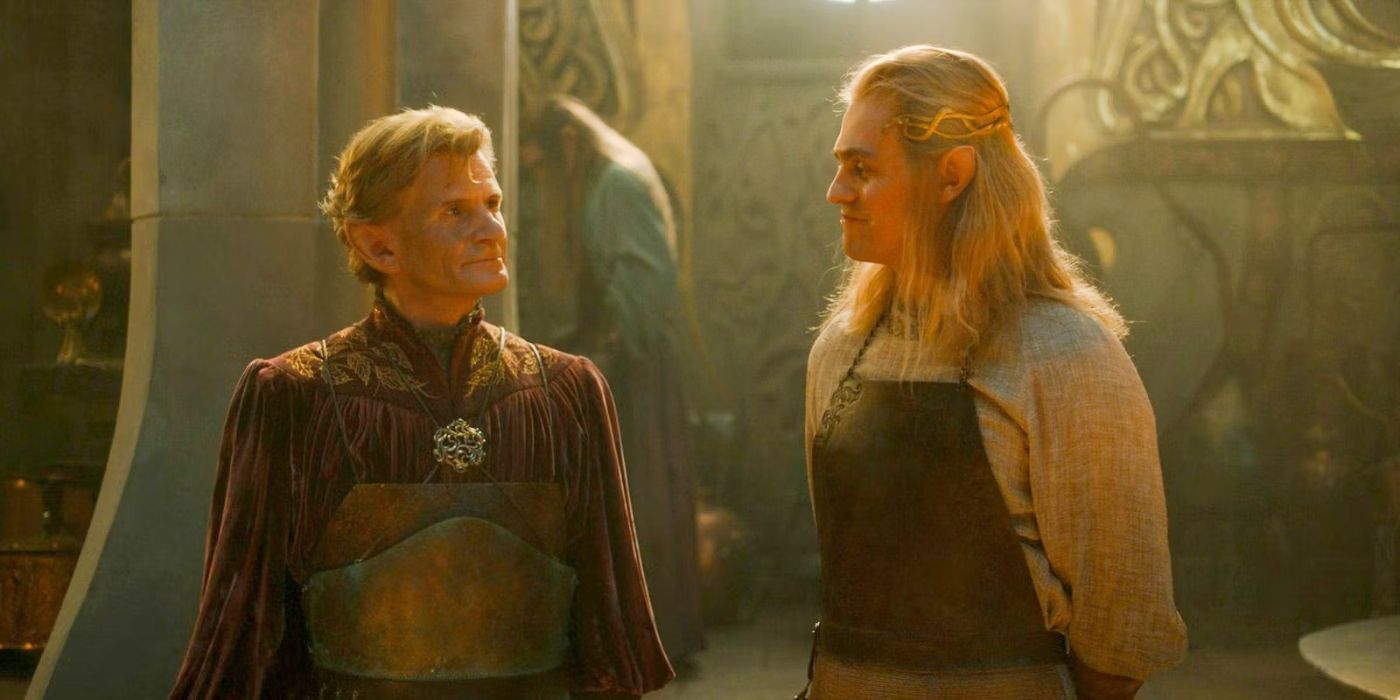
From the beginning, The Lord of the Rings: The Rings of Power gave itself the intimidating task of “humanizing” Sauron (Charlie Vickers) — not in the sympathetic way one traditionally associates with the word, but by fleshing out the Dark Lord into the multidimensional character that Rings of Power‘s prequel setting requires. Season 2 has accomplished this goal to remarkable effect; the action in Eregion has unfolded like a slow-burn psychological thriller, building to a point of no return as Sauron wields malevolence and cunning as his weapons of choice. During Episode 6’s devastating closing moments, the series’ atmosphere shifts from delicately foreboding to deeply unsettling, with Sauron unleashing an unforeseen level of villainous predation and power — all while hardly lifting a finger.
Sauron Is a Master Manipulator in ‘The Rings of Power’ Season 2

Selling Sauron as a layered figure who actively moves through J. R. R. Tolkien‘s world instead of the simplistic perception popularized by director Peter Jackson‘s The Lord of the Rings trilogy required not just the casting coup that Vickers has proved to be, but Rings of Power knowing how to differentiate their version from his more famous counterpart — but keep him just as frightening. Jackson’s Sauron exudes a nearly omniscient menace appropriate for the trilogy’s scope. The Sauron of Rings of Power, meanwhile, is just as single-minded but employs subtle manipulation over brute force. Even before the titular Rings start influencing their wearers, this tactic is what he’s best at: playing a wolf hidden among the sheep, identifying people’s weaknesses, and weaving his way under their skin in a way they welcome even though his presence feels like a mental hangnail.
Case in point: Sauron makes it his mission to erode Celebrimbor’s (Charles Edwards) emotional stability throughout Season 2. He has systematically chipped away at Celebrimbor’s defenses by preying upon his most fallible impulses, isolating him from his faithful smiths, and leaving him without any reliable ally or recourse for escape. The Dark Lord of Mordor isn’t a hypnotist (not unless you count how the Rings corrupt their Ring-Bearers), but he orchestrates scenarios that exacerbate his target’s weaknesses and let him commandeer what he wants.
Sauron’s Illusion Combines His Cleverness, His Ruthlessness, and His Sorcery

Celebrimbor, despite being beguiled by Sauron’s trickery, is no fool. He recognizes his “friend’s” manipulative ways in earlier episodes but has basically surrendered to the trap closing over his head. However, when Adar (Sam Hazeldine) launches his assault on Eregion and Celebrimbor hears the city’s alarms sounding in response, awareness breaks through his clouded mind for the first time in weeks. Sauron assures him the city is safe, but Celebrimbor asserts his will and shoves his way outside to see for himself. Eregion’s innocent people are under his protection, and he doesn’t automatically trust this intruder’s honeyed words anymore. Even though the smith’s ambitions often override his common sense, Celebrimbor clearly cares more about Eregion’s well-being than any trivial ring.
With the cat almost out of the bag, Sauron explicitly interferes with reality: he casts a spell that shows Celebrimbor, and viewers, a peaceful vision of Eregion. The sun beams golden, its citizens laugh, and there isn’t a trace of threat in sight — in other words, it’s a utopia. Upon seeing what he most wants to see, Celebrimbor’s palpable relief turns him calm and pliant instead of confrontational. Sauron dives in for the emotional kill, reciting all of his trickery’s greatest hits and convincing Celebrimbor to resume his work.
Only once Celebrimbor’s secluded away inside the forge again does Sauron’s illusion fade into the truth. The sunlight morphs to pitch black, Adar’s fireballs rain down from the sky, and the sounds of terrified pandemonium rage: Sauron had concealed the imminent death and destruction happening around them. Not only that, those harrowing sights and sounds were occurring in real time as Sauron sweet-talked Celebrimbor into complacency. Unfazed, Sauron maneuvers through the chaos long enough to look out over Adar’s army and raise his arms like an orchestra conductor ready to lead a war-torn symphony.
Sauron’s Eregion Illusion Is His Most Intimidating Move Yet in ‘The Rings of Power’ Season 2

Even though viewers know something must be wrong when Celebrimbor hears screams from inside the forge but finds a quaint paradise outside, it’s chilling to watch the idyllic daydream devolve and realize how literally and thoroughly Sauron can warp someone’s perceptions. Up to this point, Rings of Power has only hinted at Sauron’s magical abilities, letting his reputation grow via implication. Adding sorcery to his Olympic-level manipulations is far more frightening than if Sauron had legitimately hijacked Celebrimbor’s will. And given Sauron’s ancient age, casting this specific spell is probably a walk in the park for him. If Sauron easily managed this trick, what does he have left to unleash?
Kickstarting the siege of Eregion with this scene feels both inevitable and like Rings of Power yanking the rug out from under us. The day-to-night practical effects only drive home the moment’s effectiveness: no matter how many beautiful visuals a green screen or the Volume can achieve, nothing is quite so visceral, satisfying, or disturbing as expert in-camera effects deployed exactly when they should be. As the camera spins around Sauron, keeping him centered like the eye of a storm, Eregion’s facade (and the last vestiges of Sauron’s ethereal Annatar form) falls from blissful serenity into hellish war. We realize how powerful, invasive, degrading, and cruel this iteration is, and the result is an entity who’s far more terrifying than the armored giant of Jackson’s films. After all, how can you fight an enemy when he holds the key to your mental prison?





